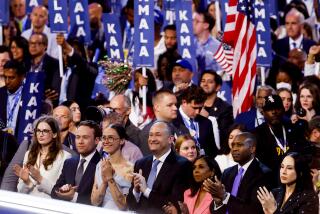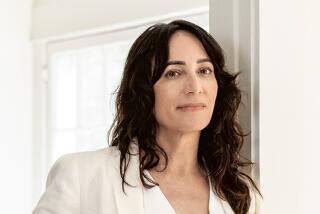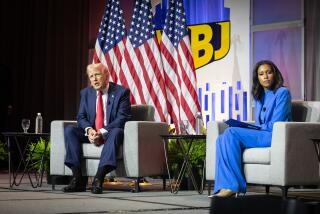Living Color : Multiracial Families Face a Constant Struggle to Fit in Without Denying Part of Their Culture
- Share via
Angela Carrington has a mahogany complexion, long dark hair, piercing brown eyes--and a mother who is white.
“Whenever my mom comes to pick me up from school the kids always ask if that’s my real mother or if I am adopted,” said the Costa Mesa fifth-grader, whose father is black. “I just keep telling them that I am mixed.” Angela’s early confrontation with the way society views her mixed heritage is one most children of interracial couples deal with throughout their lives, according to psychologists who work with multiracial groups.
“It is a constant struggle to determine who you are and where you belong,” said Reggie Daniels, professor of Latin and African-American studies at UCLA. “You don’t totally belong to either group, yet society will more than likely try to force you to be classified with one.”
As an example, the multiracial community points to Amber Jefferson, the 15-year-old Anaheim girl who was beaten by group of a men in August after a dispute and slashed in the face with a piece of broken glass. Amber is the daughter of a black father and white mother, yet is commonly referred to as black.
“I got so tired of hearing about this poor little black child, when her mother is this blond-haired woman with hazel eyes,” said Cody Donnelly, Amber’s mother. “It’s like I had no part in raising her at all over the years.”
In fact, one group, Multiracial Americans of Southern California (MASC), considered Donnelly’s dilemma serious enough to offer the family free counseling to deal with concerns arising from Amber’s mixed parentage. “That really is a prime example of what happens when you are from a mixture of cultures,” said Nancy Brown, president of MASC, which works to promote healthy interracial relations. “That is really something that bothers us because Amber isn’t black, she’s mixed. Yet that aspect is ignored by society. It’s like they are denying her the other part of her culture.”
Interracial mixing in the United States was first documented in the early 1600s.
Many of the early white settlers were indentured servants who were subject to the same indignities as fellow black servants, according to historians quoted in Lerome Bennett’s African-American history book “Before the Mayflower.” The whites, who had no organized system of racism to vent their frustration, formed close bonds with the blacks, eventually leading to intermarriage.
Due to that early mixing, it is now estimated that 20% of white Americans have at least one black ancestor, while 70% of blacks have some white or native American heritage.
Much of the negative sentiment attached to interracial relationships, and their offspring, springs from the pre-Civil War era of slavery when some white male plantation owners would force themselves on females slaves. The resultant children were called mulattoes, a term still widely used but denounced by many in the multiracial community because it also refers to a baby mule.
“Slavery is certainly where the beginning of much of the negative thinking began,” said Prof. Daniels of UCLA. The mixed offspring effectively increased the number of plantation slaves, he said, but “it was frowned upon by both races.”
In fact, noted African-American intellectuals Frederick Douglass and Booker T. Washington both had white fathers but were still born into slavery and lived in slave quarters--victims of what was known at that time as the “one-drop” rule.
“The one drop rule: it was sort of like the phrase ‘a little dab will do you,’ ” says Ray Vagus, a family counselor in Laguna Hills. “ It meant if you had any black in you, you were in fact black, and from all indications it’s a rule that blacks as well as whites still accept today.”
In 1988, the U.S. Census counted 956,000 interracial marriages in the country, with California leading the nation with 4%--twice the national average.
In Los Angeles County, 6.6% of black men are married outside their race, compared with 2.4% of white males, 2.7% of white women and 2.6% of black women, according to research done by M. Belinda Tucker, acting director for the center of Afro-American Studies at UCLA. (No comparable Orange County statistics have been published, but experts believe that it mirrors the national average.)
National census figures show that African-Americans are still the least likely to choose a partner outside the race, while Asians have the highest percentage of interracial marriages.
Though the term interracial refers to more than just black and white, the pairing of those two cultures still attracts the strongest opposition, Daniels said.
“In this culture, white is at the top of the totem pole and black is at the bottom,” Daniels said. “So some see it as one race reaching way down to get a mate while the black race is reaching high up to choose theirs.”
When Ben and Diahnn Carrington met at a wedding more than 11 years ago and decided shortly afterward to get married, they had little idea what was to come.
Like the classic Sidney Poitier-Audrey Hepburn-Spencer Tracy film “Guess Who’s Coming to Dinner,” they faced the difficult decision of how to tell their families.
For Ben Carrington, who is black, the decision to marry outside the race caused little problem with his family and friends.
“They pretty much accept my decisions on most things,” said Carrington, a sales representative for a Costa Mesa car leasing agency.
But Diahnn Carrington was alienated from her parents for years because she married a black man.
“My family was from Minnesota, where you rarely even saw black people much less associate with them,” she said. “My brothers were supportive, but my parents just couldn’t understand why I wanted to do this.”
She said her estrangement from her parents, in particular her mother, continued until shortly after Angela was born.
“It was very difficult for me because my mother and I were very close,” she said. “I think after a while she began to realize that I was never a rebellious child. If I had done this, it had to mean that I was really in love.” The question of having children was a major one for the Carringtons.
“That was my biggest concern if we had children what would they face because people can be so cruel,” Diahnn Carrington said. “Ben said the decision was up to me.”
The couple say they make extra efforts to educate Angela, who is now 10, on the history of both cultures.
“We stressed to her that she is mixed because often kids ask her about it at school,” Diahnn Carrington said. “We have friends that have interracial children and who consider the kids black, but to me that would be denying my part of the child, and I don’t want that. She is both black and white.”
Stressing the importance of both cultures is an essential part of a healthy attitude toward mixed heritage, according to Vagus, the Laguna Hills marriage and family counselor.
“Children of interracial unions go through several stages of trying to find out who they are, and a healthly respect of both cultures is really the answer to what many of them face,” said Vagus, himself the product of a mixed marriage. “And today a number of interracial couples with children are doing just that, and these children seem to be functioning very healthy.”
Many with multiracial backgrounds take pride in admitting they are a mixture of cultures, but others find more comfort in choosing to be one or the other.
Michelle Peele is the product of a black father and Puerto Rican mother, yet the Capistrano Valley High School junior considers herself black.
“I understand that I am mixed, but my experiences for the most part have been black,” said Peele, 16, who lives with her father in Laguna Niguel. “People ask me all the time what I am and usually it just depends how much detail I want to go into it that day. But as a rule, I consider myself black. I feel black, I want to go to attend a black college, and I love rap music.”
Cheryl Oshiro, meanwhile, has dealt with her many heritages for 42 years and is still searching.
“My mother was the product of a mixed relationship and I knew what she went through,” said Oshiro, whose mother was black and white, while her father was black and American Indian.
“When she was young there was no choice. She was considered black and that was it, and now some 30 years later I am dealing with the same thing,” Oshiro said.
Married to an Asian man with two children, Oshiro said she goes out of her way to make sure she isn’t considered an African-American.
“It’s very painful, but at times I don’t even want to be seen with my black relatives because then I immediately become less than the ambiguous person than I was. People will stop seeing me as just a person and start labeling as black because in the country black has such a negative meaning and that negativity is so powerful. It consumes who you are.”
Oshiro added that at work she even distances herself from other African-American employees to avoid speculation by office mates.
“It is really difficult because you find that neither race is reaching out to accommodate you because you choose to not to choose,” Oshiro said. “The black race gets upset if you don’t want to associate or identify with them, and the white race is busy still trying to figure out what you are.” For many in the African-American community, the idea of mixed marriages and their offspring still generates a broad spectrum of emotions ranging from curiosity to concern, and even rage.
Popular African-American magazines such as Ebony and Essence regularly feature articles that discuss who is black and who isn’t. Top entertainers Paula Abdul and Prince are among those whose ethnic background has been questioned.
“In the black community, if a mixed person admits to being black or strongly identifies with the black race, he is totally accepted by the community,” Vagus said. “But if he denies that he is black and in particular if he looks like a person of color, he faces the same type of ridicule that he might get from the white community.”
For Michael Boyd , who is black, dealing with the often negative attitudes of black women has been his biggest obstacle since marrying his white wife 15 years ago.
The Boyds, who live in Santa Ana with their two teen-age sons, say they often get angry stares and are called insulting names by females of color.
“I can remember one time when a black woman yanked my wife by the arm and called her ‘poor white trash,’ ” Boyd said. “They really resent my choice and go out of their way to let me know it.”
The Rev. John McReynolds, pastor of the Second Baptist Church in Santa Ana , explains that much of the anger black women have toward interracial pairing stems from a sense of loss.
“When you look at the numbers of one in four black males being in jail or on probation, the numbers of a young black male being murdered or on drugs or dying of AIDS, and the many other problems facing the black male, you see a shortage of productive young black men,” McReynolds said. “So, of course, when the ones that are productive and eligible look outside the race for companionship it is a great loss for black women because that is one less black male they have to choose from.”
McReynolds added that because of society’s tendency to display white females as the example of what is beautiful, white males and males of other cultural groups are not as likely to choose a black woman for a mate.
But many in the multiracial community are expecting that to change soon.
“For years the white male has been the dominating person over people of color and women,” Vagas said. “This is one reason why black men and white women are more easily paired because they share the common bond of discrimination. Black women and white men don’t have that , though because of the current circumstances the numbers will probably experience some increases.”
Multiracial groups say ultimately what they want most is be considered what they are -- a variation of cultures, ideas and backgrounds, but many others in the field say it will take a total reorganization of America’s attitude toward minorities as a whole before that happens.
“Race is really just a way to classify people socially and economically,” Daniels said. “And until that one characteristic ceases to be used to judge people, the situation . . . will continue and so will the attitudes toward people with mixed blood.”
More to Read
Sign up for Essential California
The most important California stories and recommendations in your inbox every morning.
You may occasionally receive promotional content from the Los Angeles Times.













